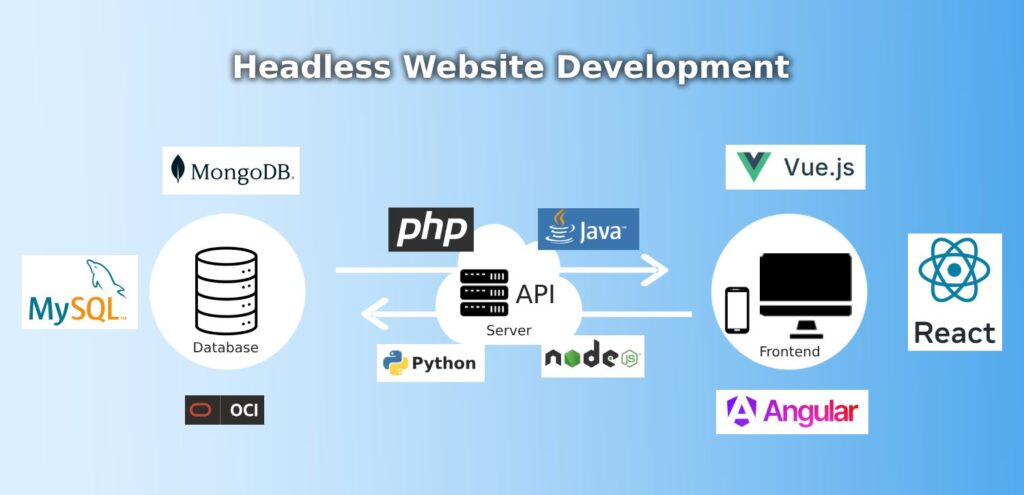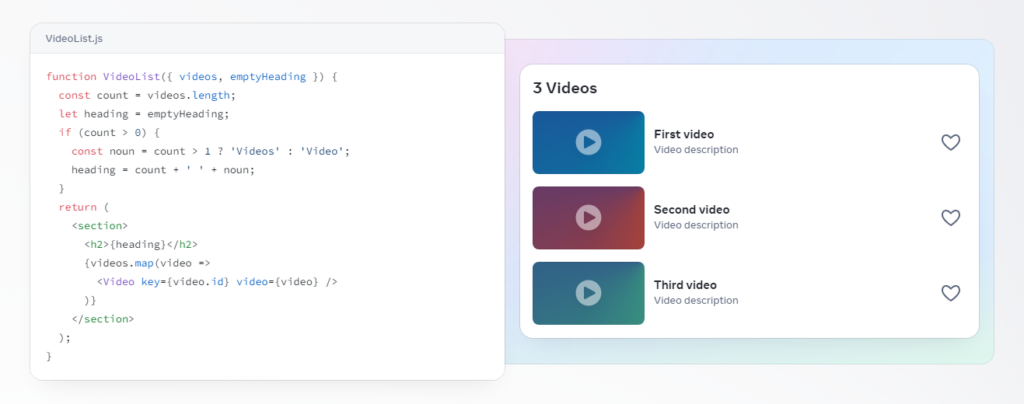The term Headless Web Development is creating a buzz in the world of modern web solutions. If you are a business owner, marketer, or developer, understanding this concept is essential to keep up with the ever-evolving digital landscape. This article explores what headless website development is, its benefits, and why it’s becoming a game-changer for businesses worldwide.

What is Headless Web Development?
Headless web development refers to a decoupled architecture where the front-end (presentation layer) is separated from the back-end (content management system or application logic layer) of a website. This separation allows for greater flexibility, scalability, and customization compared to traditional monolithic website architectures.
In a traditional website, the front-end and back-end are tightly coupled. The front-end code (HTML, CSS, JavaScript) is typically generated by the back-end server-side scripting language (e.g., PHP, ASP.NET). This approach can be limiting, as any changes to the back-end can potentially impact the front-end, and vice versa.
Headless web development breaks this dependency. The front-end is built using modern JavaScript frameworks like React, Angular, or Vue.js, while the back-end leverages a headless CMS (Content Management System) or a custom API to manage content and application logic. An API (Application Programming Interface) acts as a messenger between the front-end and back-end, facilitating the exchange of data.

How Does Headless Web Development Work?
The process of Headless Web Development involves three main components:
- Back-End CMS: The back-end stores all the content and functionalities without dictating how they should be presented to the user.
- APIs: These serve as a bridge between the back-end and the front-end, allowing data to flow seamlessly.
- Front-End Frameworks: Developers can use modern frameworks like React, Angular, or Vue.js to create custom, dynamic, and engaging user experiences.
For instance, a business might use headless architecture to create a unified experience across its website, mobile app, and smart devices without needing to duplicate content or design elements.
Headless Web Development tools
Headless web development relies on various tools for content management, API handling, front-end development, and hosting. Here’s a categorized list of essential tools:
1. Headless CMS (Backend)
These CMS platforms provide content via APIs (REST/GraphQL) without a built-in front-end:
- Strapi – Open-source, self-hosted, customizable
- Contentful – Cloud-based, enterprise-friendly
- Sanity – Real-time collaboration, structured content
- WordPress (WP REST API) – Use WordPress as a headless CMS
- DatoCMS – API-first, optimized for performance
- Ghost – Headless blogging platform
- Prismic – Slice-based CMS for reusable components
2. API Management & Middleware
These tools help fetch and manage data from the CMS efficiently:
- GraphQL – Query language for APIs, used with CMS like Strapi & Contentful
- REST API – Standard API communication format
- Apollo – GraphQL client for managing API requests
- Express.js (Node.js) – Middleware for custom APIs
- Next.js API Routes – Serverless API handling in React
3. Front-End Frameworks
These tools build the UI while fetching content from the headless CMS:
- Next.js (React.js) – Server-side rendering, static site generation
- Nuxt.js (Vue.js) – Vue-based alternative to Next.js
- Gatsby.js – Static site generator optimized for performance
- Remix – Full-stack React framework
- Angular & SvelteKit – Other front-end frameworks for dynamic UI
4. Hosting & Deployment
For hosting and serving front-end applications:
- Vercel – Best for Next.js & static sites
- Netlify – Serverless hosting, easy CI/CD integration
- AWS Amplify – Scalable hosting for Jamstack apps
- Cloudflare Pages – CDN-powered hosting
- Firebase Hosting – Google-powered fast hosting
5. eCommerce (Headless Commerce)
Headless eCommerce platforms that work via API:
- Shopify Hydrogen – React-based headless eCommerce
- BigCommerce Headless – API-driven commerce
- Commerce.js – Lightweight eCommerce API
- Saleor – GraphQL-based eCommerce solution
Benefits of Headless Web Development

1. Flexibility and Customization
With Headless Web Development, developers can choose the front-end technology that best suits their project’s needs. This allows for highly customized and unique user interfaces.
2. Improved Performance
Decoupling the front-end from the back-end enables faster loading times and improved performance. Content can be delivered efficiently using APIs, which is crucial for enhancing the user experience.
3. Omnichannel Delivery
Headless architecture enables businesses to deliver content across multiple platforms, including websites, mobile apps, IoT devices, and even social media. This capability is essential for companies focusing on Digital Marketing, Social Media Marketing, and SEO.
4. Enhanced Security
By separating the front-end from the back-end, headless websites reduce vulnerabilities and enhance security. Sensitive data is stored on the back-end, which is not directly accessible from the front-end.
5. Scalability
As businesses grow, they can scale their platforms without affecting the user interface. This flexibility makes headless development an ideal choice for dynamic industries like Website Development and Email Marketing.
6. Future-Proofing
Headless architecture is not tied to any specific technology stack. This makes headless websites more adaptable to future changes in technology and user behavior.
Headless vs. Traditional Web Development
| Aspect | Headless Development | Traditional Web Development |
| Flexibility | Highly customizable | Limited customization |
| Performance | Faster and optimized | Dependent on framework |
| Omnichannel Support | Excellent for multiple platforms | Limited to web and mobile |
| Scalability | High | Lower |
| Security | Enhanced | Moderate |
| Maintenance | Easier to manage updates | Can be slower, less interactive |
Use Cases of Headless Web Development

1. E-Commerce Platforms
E-commerce businesses require dynamic interfaces and seamless integrations with various payment gateways, inventory systems, and marketing tools. Headless architecture is ideal for creating responsive and scalable e-commerce websites.
2. Content-Driven Websites
Publishers and media companies can leverage headless development to distribute content across multiple platforms, improving engagement and reach.
3. Digital Marketing Campaigns
With the growing reliance on Social Media Marketing and SEO, headless websites allow marketers to push content efficiently to various digital channels.
Challenges of Headless Web Development
While the benefits are significant, it’s important to consider the challenges:
- Higher Initial Costs: Setting up a headless architecture can be more expensive initially due to the need for advanced technologies and expertise.
- Complex Development: Requires skilled developers familiar with APIs and modern frameworks.
- Maintenance: Regular updates and monitoring of APIs are necessary to ensure smooth functionality.
Is Headless Web Development Right for You?
The decision to adopt Headless Web Development depends on your business goals and technical capabilities. If you aim to provide a seamless user experience across multiple channels, invest in customization, or enhance performance, headless architecture is worth considering.
Businesses in industries such as Digital Marketing, Website Development, and Social Media Marketing can benefit immensely from this approach.
FAQ About Headless Web Development
What is a headless website?
A headless website is a website where the frontend (presentation layer) is decoupled from the backend (content management and storage). Instead of being tightly integrated, the frontend consumes data through APIs to render content dynamically. This allows flexibility in designing the frontend while using the same backend across multiple platforms like web, mobile, or IoT devices.
What is the headless concept?
The headless concept refers to separating the frontend (the “head”) from the backend. The backend provides content or data via APIs, while the frontend independently renders the data. This approach allows developers to use any technology to build the user interface, offering greater freedom, scalability, and cross-platform compatibility.
What is the difference between headless and CMS?
Traditional CMS (Content Management System): Combines both frontend and backend, where the backend handles content storage, management, and directly renders the frontend. Examples include WordPress or Joomla.
Headless CMS: Only provides content storage and management. It exposes content via APIs for use by any frontend technology. Examples include Strapi or Contentful.
The main difference is that a traditional CMS manages both content and presentation, while a headless CMS focuses solely on content delivery, leaving presentation to separate frontend systems.
What does “headless” mean in coding?
In coding, “headless” typically refers to systems, applications, or browsers that operate without a graphical user interface (GUI). For example:
A headless CMS delivers content via APIs without controlling the UI.
A headless browser runs web applications without displaying a UI, useful for automated testing or scraping.
What is an example of a headless frontend?
An example of a headless frontend is a React or Next.js application that fetches content from a headless CMS like Contentful or Strapi via APIs. The frontend handles the presentation, while the CMS delivers content in a structured format.
Is a headless CMS a backend?
Yes, a headless CMS functions as a backend system. It manages content storage, retrieval, and delivery through APIs. However, it doesn’t handle the frontend (presentation layer), which is why it’s referred to as “headless.”
What is the use of headless?
The headless architecture is used to:
Build flexible and customizable frontend experiences.
Deliver content across multiple platforms (web, mobile apps, IoT devices).
Enable faster performance and scalability by decoupling frontend and backend.
Allow teams to work independently on frontend and backend systems.
What is the full form of headless CMS?
The full form of headless CMS is Headless Content Management System.
Why Choose Labhanya Technologies for Headless Web Development?
Labhanya Technologies specializes in innovative web solutions tailored to your business needs. From crafting stunning websites to implementing advanced SEO strategies, our team has the expertise to take your digital presence to the next level. Whether you need assistance with Email Marketing, Social Media Marketing, or Website Development, we’ve got you covered.
Explore our services:
- Digital Marketing Services
- Social Media Marketing
- Search Engine Optimization (SEO)
- Website Development
- Facebook Advertising
- Instagram Advertising
- YouTube Marketing
- Domain Checker
Final Thoughts
Headless Web Development represents the future of web architecture. Its ability to deliver flexibility, scalability, and enhanced performance makes it an excellent choice for modern businesses. By embracing this approach, companies can stay ahead in a competitive digital landscape, making it easier to leverage tools like Digital Marketing, SEO, and Social Media Marketing effectively.
For cutting-edge web solutions and unparalleled digital marketing services, we recommend Labhanya Technologies—your partner in achieving online success. Visit our website to learn more about our services.
